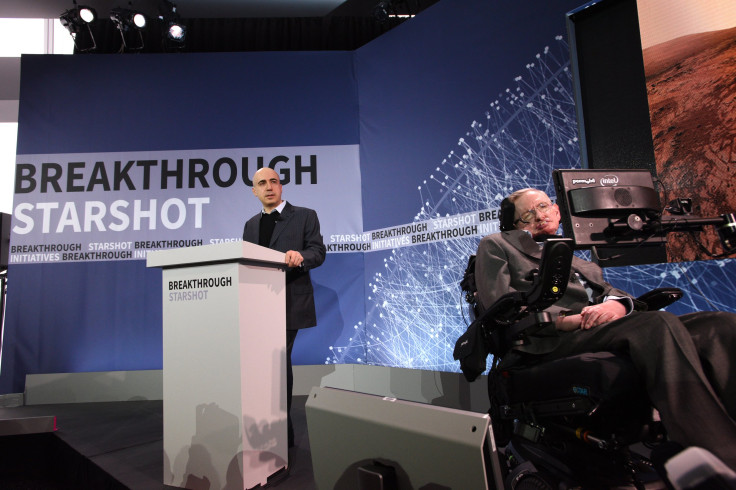Breakthrough Starshot: Yuri Milner And Stephen Hawking Launch $100M Interstellar Mission To Alpha Centauri

The future of space exploration will be nano-sized, but fueled by outsized ambitions. Breakthrough Starshot is a mission that may never achieve success, but it could be a boon to empowering the technology necessary to transport humans or man-made spacecraft to the stars. Billionaire Yuri Milner and famed theoretical physicist Stephen Hawking announced Tuesday the $100 million initiative to send tiny spacecraft, which could be as small as a computer chip, to the Alpha Centauri, the nearest star system, 25 trillion miles from Earth.
On the 55th anniversary of Yuri Gagarin becoming the first human to launch into space, Breakthrough Starshot is a bold idea to make interstellar exploration a reality. Joining Milner and Hawking on the Breakthrough Starshot board will be Facebook founder and CEO Mark Zuckerberg. The trio is backed by a management and advisory committee that includes executive director Pete Worden, former director of NASA Ames Research Center, and esteemed researchers from Harvard University, Princeton University, the Planetary Society, Cornell University, Nobel Prize winner Saul Perlmutter and Astronomer Royal Lord Martin Rees.
In a lot of ways, space exploration has not changed in six decades. The proposed Dragon V2 craft from SpaceX that will ferry astronauts to the International Space Station doesn't look much different from the Apollo capsule that put astronauts on the moon.
In 1999, the miniaturization of space flight began taking shape with the development of the CubeSat standard. Created by California Polytechnic State University, San Luis Obispo and Stanford University, miniature satellites measuring around 10 x 10 x 10 cm could be made from off-the-shelf electronics for a fraction of the cost. FemtoSats takes that concept a step further with cubes measuring just 3 cm with a mass of 35 grams. The satellites are so tiny, Arizona State University used a penny for reference.
KickSat, developed by the Space Systems Design Studio at Cornell University, are the size of computer chip with a gyroscope, radio, microcontroller and an attached antenna. This design was a source of inspiration for Milner in his ambition to reach Alpha Centauri.
Breakthrough Starshot will investigate whether it is possible for a nanocraft, essentially a computer chip with a thruster, power supply, cameras and navigation system, to be developed. If the StarChip can become a reality with the advances in technology as dictated by Moore's Law — the observation that the number of transistors on a chip doubles almost every two years — the next hurdle would involve the development of a meter-sized Lightsail that is just a few hundred atoms thick.
Propulsion would be much different than the traditional rocket launch. Breakthrough Starshot plans on creating a ground-based array of lasers, dubbed the light beamer. The group of lasers would, in theory, be able to launch thousands of nanocraft into space. Once in orbit, light beamers can target individual lightsails to get them to speeds of 20 percent of the speed of light. Instead of 30,000 years to reach Alpha Centauri, the StarChip could get there in 20 years by traveling 100 million miles per hour. If the StarChip reaches its destination, the onboard camera could begin taking photos of the star system to determine if there is a potentially habitable planet. Even with the advanced technology, it would take four years before the photos reached Earth.
Breakthrough Starshot is in its very early infancy with many technological challenges to overcome. It's a fascinating proof-of-concept project that would also have to address the dangers of an interstellar journey. Any collision could end the mission.
"Earth is a wonderful place, but it might not last forever," Hawing said in a statement. "Sooner or later, we must look to the stars. Breakthrough Starshot is a very exciting first step on that journey."
© Copyright IBTimes 2024. All rights reserved.






















